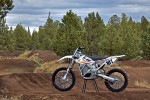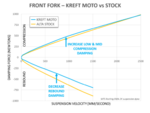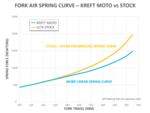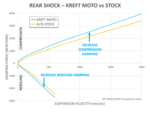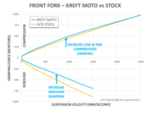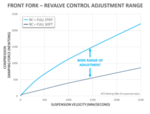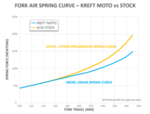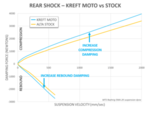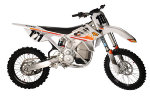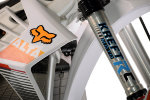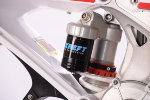ALTA MXR - DETAILS
2018 ALTA MXR – ELECTRIC MX BIKE
Kreft Moto staff recently spent three weeks testing a 2018 Alta MXR, the electric motocross bike built in California. You may have seen Josh Hill riding an Alta in the Red Bull Straight Rhythm supercross event last year, where it proved to be remarkably competitive.
The Alta comes with the same WP suspension components we know from KTM and Husqvarna, so it is potentially a good fit for Kreft Moto services. We wanted to evaluate the stock suspension and see what we could do to improve it. Naturally, we were also just curious to ride it.
SUSPENSION ANALYSIS
The Alta uses the same WP AER 48 fork and linkage shock that come on new KTM/Husqvarna motocross bikes. However, the valving is nothing like a KTM, or Husqvarna, or any other gas-powered bike. The damping forces are so far from a typical motocross bike, at first, we thought the dyno test results were some kind of error.
The fork generates at least double the compression damping force we normally see. The shock is just the opposite – it produces only half the compression damping of a typical motocross shock. It is in the ballpark of settings we use for technical enduro terrain, not MX.
On a gas-powered bike, two-stroke or four-stroke, this setting would have the suspension balance of a chopper, with a rock-hard fork and an absurdly bouncy shock. But that’s not how the bike rides. Actually, we found it to be pretty well balanced after changing the shock spring. So, what explains the bizarre setup?
First, the Alta is just plain heavy at 262.4 lbs. Also, the center of gravity is higher and farther forward than a typical gas-powered bike. We estimated the center of gravity to be about 21mm higher and 25mm farther forward than a KTM 350 SX-F we used for comparison. The weight is distributed 49.6% front and 50.4% on the rear, versus 47.9% front and 52.1% rear for the KTM.
Other major differences include the lack of clutch and transmission, lack of a spinning crankshaft, and the completely different power deliver characteristics. To their credit, Alta chassis design engineers clearly recognized the need for a unique suspension setup and appear to have started from scratch instead of using a weight-scaled version of an existing motocross setting.
The suspension is weirdly soft for a bike designed for a motocross track. It is simply not adequate for even an intermediate rider on a full-size track. The upside to the soft suspension is that it is quite plush over certain obstacles. The fork in particular, aided by the substantial mass of the battery acting as ballast against the force of impacts, will mow down sharp bumps and even rock ledges. However, this plushness erodes in rapid sequential bumps (like braking bumps) as the combination of minimal compression damping and excessive rebound damping induce packing. Alta appears to have overcompensated for the higher spring forces required to support the bike’s weight, and the rebound damping on the fork is too stiff.
You may not bottom out the suspension despite the soft setting. The AER 48 has excellent bottoming resistance and the shock’s bottom out bumper prevents the metal-to-metal clank. However, that does not necessarily mean the stroke is being utilized effectively. Since the suspension blows through the majority of travel on modest jump lips and landings, it leaves most of the impact force to be absorbed in the last few inches of travel. A large force absorbed over a short distance is what we experience as harshness.
Motocross suspension needs enough low-speed compression damping to support aggressive riding. If it gives up travel too easily, the bike will be uncontrollable at higher speeds or bigger bumps. For example, imagine a rider braking hard into a corner. The fork naturally dives, and while the fork is compressed, the rider hits a big braking bump. A fork sags roughly 30% standing still, and brake dive could easily bring it down another 30%. The fork has already used 60% of the travel before it even hits the bump! In this scenario, the fork will not be able to absorb the bump effectively and the rider could lose control.
We found the OEM 60 N/mm shock spring to be much too stiff for a 175-pound rider. With sag set to 102mm, the spring had no more than one millimeter of preload where we would normally expect 10mm. Most motocross bikes come from the factory tuned for a 175-pound rider, but perhaps Alta decided to break with tradition and target the 200+ pound riders of the world. The other possibility is that the spring choice reflects Alta’s suspension tuning philosophy. Some schools of thought prescribe stiff springs paired with soft damping as a way to achieve a firm feel with good compliance on sharp bumps. This is an oversimplified approach to a complex engineering problem, so we’ll give Alta the benefit of the doubt and assume the stiff spring was selected to suit their typical 200 lbs American customer.
Whatever the case, it didn’t work for our 175 lb test riders. The shock was oversprung and underdamped, just as our measurements had predicted. The rear tends to kick up and slap your butt on obstacles that tap both wheels in sequence, like whoops and some jump faces. This tends to push the rider’s weight farther forward at the precise moment when you want it to be farther back, giving the uneasy sensation of an impending endo.
The shock linkage has a relatively flat leverage curve. It is similar to the enduro-style linkage used on 2018 and 2019 Husqvarna TE and FE models, and notably not like the KTM SX/SX-F linkages. The shock has a bouncy, free-moving feel also reminiscent of enduro suspension. We didn’t like that quality for motocross. It causes pitching, where weight shifts excessively between front and rear wheels instead of providing a solid platform. That constant pitching gives the rider an uncontrolled feeling and causes the tires to lose grip.
RIDE IMPRESSIONS
The Alta is at its best in corners. The instant-on torque makes it easier to ride in a long rut because you can adjust your balance just by modulating the throttle. We do that naturally with any bike, it’s just more noticeable with the Alta because the bike responds to the correction so fast.
The power fades at higher RPMs, and top-end power does not compare favorably to a 350 SX-F. The Alta launches out of corners but kind of leaves you hanging on the straights. To clear some the bigger doubles with the Alta, we felt we had to use the highest power setting to get the necessary speed. That power setting is ferocious at low speeds but, feels tame on the straightaways. (Granted, the bike has NO gears. Adding a transmission would add significantly to cost and complexity of the machine).
One really cool thing about the Alta is that it needs next to no maintenance. It has fewer parts than an equivalent gas-powered bike, so there is less to go wrong and less to take care of. The flip side is that your ride day is over when the battery dies because you can’t just add gas and keep riding. The battery will last for several hours of less demanding use, like trail riding at a low power setting. At full tilt on a motocross track, it’ll be dead within an hour. There is no easy way to swap in a new battery, and even if there were, a spare would likely be very expensive.
SUSPENSION TUNING
We swapped the OEM shock spring for a 57 N/mm. We settled at 102mm rider sag, which gave 30mm static sag when set for a 175 pound rider. The spring change was a big improvement. Though still underdamped, the shock was no longer constantly overpowering the fork.
We then began to work through our normal suspension development cycle: revalve, dyno, ride, repeat. Repeat and repeat until the bike comes into focus and meets performance expectations.
We installed Revalve Control in the fork using the same parts package we use in the KTM and Husqvarna AER 48, but of course, we install the valving setting is completely different. Revalve Control is not just for terrain versatility, it’s also a huge problem solver for our customers. It allows the rider to try different valving settings and, ultimately, to better understand his preferences. It also resolves much of the communication difficulty that can happen between rider and tuner in the search for the ideal setting. The ability to revalve remotely and get instant feedback makes it so much easier for us to diagnose and resolve tuning issues. It is a very powerful tool.
As expected, our final settings are much stiffer than OEM. We dramatically increased low speed compression damping in both the fork and shock, and massaged the shape of the curve to better match the Kreft Moto “firm but plush” target feel. We also made major changes to rebound damping, including revised valving and reduced free bleed to eliminate the bouncy feel and reduce the tendency to pack up on braking and acceleration bumps.
By the time our tuning session concluded, the MXR was a serious motocross bike capable of competing head-to-head with the best traditional bikes. The thing is a flat blast to ride. If you like the idea of showing up to your local motocross track with a fast bike no one else has, but everyone is dying to check out, the Alta is the best way to do it.

